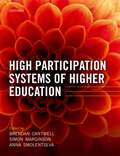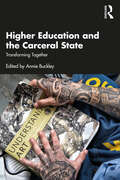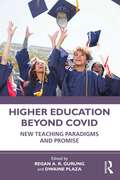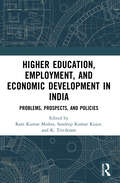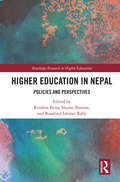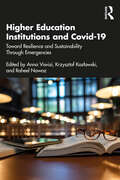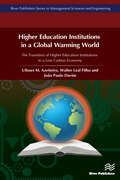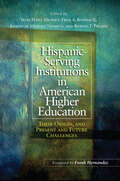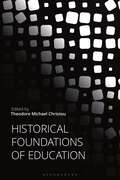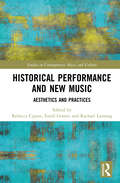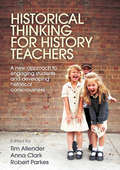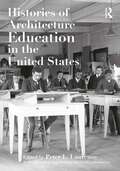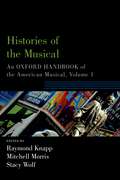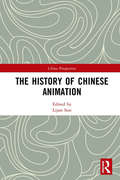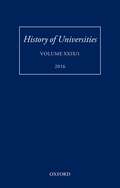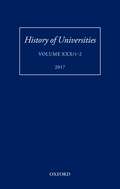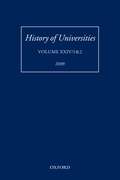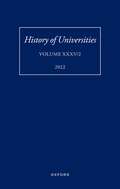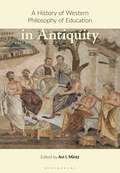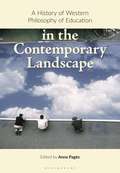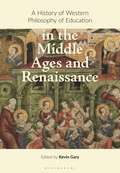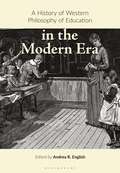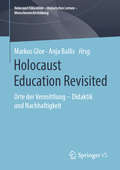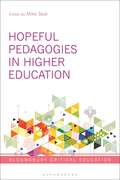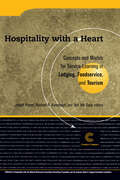- Table View
- List View
High Participation Systems of Higher Education
Higher Education has become a central institution of society, building individual knowledge, skills, agency, and relational social networks at unprecedented depth and scale. Within a generation there has been an extraordinary global expansion of Higher Education, in every region in all but the poorest countries, outstripping economic growth and deriving primarily from familial aspirations for betterment. By focusing on the systems and countries that have already achieved near universal participation, High Participation Systems of Higher Education explores this remarkable transformation. The world enrolment ratio, now rising by 10 per cent every decade, is approaching 40 per cent, mostly in degree-granting institutions, including three quarters of young people in North America and Europe. Higher Education systems in the one in three countries that enrol more than 50 per cent are here classified as 'high participation systems'. Part I of the book measures, maps, and explains the growth of participation, and the implications for society and Higher Education itself. Drawing on a wide range of literature and data, the chapters theorize the changes in governance, institutional diversity, and stratification in Higher Education systems, and the subsequent effects in educational and social equity. The theoretical propositions regarding high-participation Higher Education developed in these chapters are then tested in the country case studies in Part II, presenting a comprehensive enquiry into the nature of the emerging 'high participation society'.
Higher Education and the Carceral State: Transforming Together
Higher Education and the Carceral State: Transforming Together explores the diversity of ways in which university faculty and students are intervening in the system of mass incarceration through the development of transformative arts and educational programs for students in correctional institutions.Demonstrating the ways that higher education can intervene in and disrupt the deeply traumatic experience of incarceration and shift the embedded social-emotional cycles that lead to recidivism, this book is both inspiration and guide for those seeking to create and sustain programs as well as to educate students about the types of programs universities bring to prisons.From arts workshops and educational courses to degree-granting programs, individuals and communities across multiple disciplines in higher education are actively breaking the cycle of shame and division in mass incarceration through direct engagement. This book explores the inspiring, innovative, and changemaking initiatives in carceral spaces - from arts workshops and educational courses to degree granting programs - through the lens of faculty, artists, scholars, students, and administrators. Readers will learn the diverse ways in which these interventions and partnerships can take shape and the life changing impacts that they have on all those involved, in particular students who are incarcerated. The book includes authors with lived experience of incarceration throughout.Section I highlights the voices of students who are currently or formerly incarcerated, while Section II addresses diverse collaborations through and across systems of corrections and education. Section III features the voices of teaching artists, while Section IV includes those that start and lead these programs, offering roadmaps for others interested in engaging in this transformative work.
Higher Education Beyond COVID: New Teaching Paradigms and Promise
This book illustrates how higher education responded to the COVID-19 pandemic and grew from it. The pandemic impacted faculty development, drew a greater focus on the measurement of effective teaching in higher education, and provided a better understanding of what was needed to better aid educators in colleges and universities nationwide. The stage is set for a more resilient higher education with chapters illustrating new paradigms and promise. Three themes are highlighted throughout this volume. Authors underscore the need to explore different modalities of delivery for faculty development and instruction, to enhance the leverage of technology in course design, and to refine faculty development for holistic development. Pulling together empirical data on college faculty administration, and student responses to the pandemic, chapter authors address the unique issues faced by educators and highlight successes and challenges in working with existing Centers for Teaching and Learning (CTLs) and information technology structures. Featuring contributions from diverse institutions, each chapter provides specific guidelines and recommendations for higher education to set the stage for innovation and change. Laying the groundwork for the design of more effective models of faculty development for higher education, this book is a valuable resource for higher education administrators and faculty to improve higher education going forward.
Higher Education, Employment, and Economic Development in India: Problems, Prospects, and Policies
This volume examines the role of higher education and employment in economic development in emerging economies like India. It looks at the contours of higher education policies and the labour market dynamics to explore ways to address joblessness and income disparity. The book discusses themes such as quality and access to higher education, the shift towards private investment in higher education, demographic dividend and joblessness among youth, social and income inequalities, labour migration and employment, and the participation of women in the workforce, among others. It provides insights into the challenges relating to employment generation in the industrial sector. It also offers solutions and policy measures to move towards sustainable growth, better employment opportunities in various sectors of industries, and human development. Rich in empirical data, this volume will be of interest to students and researchers of education, economics, development studies, sociology, gender studies, and social and economic policy.
Higher Education in Nepal: Policies and Perspectives (Routledge Research in Higher Education)
This book presents a showcase of discussions and critical perspectives about Nepalese higher education. Its chapters cover topics such as the impacts of local sociopolitical changes and global forces on public and private education, emerging online and distance education, administrative and intellectual leadership, quality assessment, graduate employability, global mobility of students, and the contributions of global diaspora of Nepalese scholars. The central questions of the book are: What are some of the local and global academic interactions in Nepalese higher education and what are the current challenges and pathways for advancements and improvements? How can Nepalese higher education absorb twenty-first century values of quality education as external forces, while adapting new developments to local needs? How can scholars interested in Nepalese, South Asian, and international higher education create opportunities for scholarship and professional collaboration around research on higher education in this region of South Asia? What issues and perspectives can research and scholarship about Nepal’s higher education offer to international discourse in higher education? The book offers information and resources to international educators interested in the dynamics of Nepalese and, by implication, South Asian higher education by introducing key challenges in policy and programs, innovative changes in curricula, effective approaches in technology application, and strategies for future integration of global reforms in education.
Higher Education Institutions and Covid-19: Toward Resilience and Sustainability Through Emergencies
Offering insights into the adaptational strategies that were employed by higher education institutions worldwide during the Covid-19 pandemic, this volume considers the lasting effects of adaptation and change, as well as the perception of universities’ role in society and desired ways of operating. Nearly overnight, the pandemic forced university leaders and faculty across the world to switch to remote models, not only of teaching and learning but also of managing an entire institution. This book recognizes how the scale of challenges as well as the range of measures specific universities had to undertake was uneven, with some being better equipped than the others. Using a selection of international case studies, it offers an insight into strategies employed by institutions worldwide to navigate the crisis, and highlights the targets and objectives addressed by them during these processes. In so doing, it offers invaluable lessons for the years to come. An indispensable study into strategies that result in resilience and sustainability for universities, this book is essential reading for scholars of education, pedagogy, and organizational change in the higher education sector, as well as educational leaders around the world.
Higher Education Institutions in a Global Warming World
Higher Education Institutions in a Global Warming Worldaims to contribute to the global debate on Sustainability in Higher Education, and in particular to the transition of Higher Education Institutions to a Low Carbon Economy.The transition of Higher Education Institutions towards a Low Carbon Economy is aligned with the Paris Agreement, and with Sustainable Development Goal 13: Take urgent action to combat climate change and its impacts. It is also consistent with the European Commission´s Climate strategies and targets and with the aims of the European Climate Change Program.Transitioning to a low carbon economy represents one of the most significant and urgent challenges we are facing, and Universities have a critical role to play in fostering a low carbon future, especially by developing innovative solutions.
Hispanic-Serving Institutions in American Higher Education: Their Origin, and Present and Future Challenges
This is the first book to exclusively address Hispanic Serving Institutions (HSIs), filling a major gap in both the research on these institutions and in our understanding of their approaches to learning and their role in supporting all students while focusing on Hispanic students. Born out of the reauthorization of the Higher Education Act of 1992 and are classified as such if their enrollment of Latino students account for a quarter of their undergraduate enrollment, the number of HSIs and their impact in higher education is growing. Today there are approximately 370 HSIs, 277 emerging HSIs, and their numbers are steadily increasing. Given the projected growth of the Latino population, and HSIs’ record of advancing the success for Hispanic students in STEM fields, as well as of graduating nearly a third of all Hispanic bachelor’s degree recipients, their work has important implications for higher education at large.Written by leading and rising scholars on HSIs, this book offers insight into the complexity of these institutions. It not only addresses historic policy origins, but also describes the experiences of various student populations served, faculty issues (i.e., governance, diversity, work/life experience, etc.), the impact of student affairs in advancing student development, and considers funding and philanthropy efforts. The book also critically examines challenges that many of these institutions face – disjointed mission statements regarding support of their Latino/a student populations, governance structures that support the status quo, and the financial incentive to achieve HSI designation that may not correlate with enhancing the climate for Latinos. This book touches on the many facets of HSIs, painting an organic mosaic of institutions in position to advance Latino postsecondary progress, both chronicling the contemporary challenges that these institutions face while also looking to their future.
Historical Foundations of Education
This volume considers history as a foundational discipline in education. It shows how history is a means for exploring what it means to be human by considering those stories, sources, forces, and contexts that shape the way we construct narratives. History is more than content, no matter what we might recall from our experiences in schools. The volume shows how studying history is one means of uncovering why institutions, beliefs, policies, and practices are as they are. Educational structures are, like all things, mutable. History empowers the individual to be an actor in this process of change and to act judiciously. About the Educational Foundations series: Education, as an academic field taught at universities around the world, emerged from a range of older foundational disciplines. The Educational Foundations series comprises six volumes, each covering one of the foundational disciplines of philosophy, history, sociology, policy studies, economics and law. This is the first reference work to provide an authoritative and up-to-date account of all six disciplines, showing how each field's ideas, methods, theories and approaches can contribute to research and practice in education today. The six volumes cover the same set of key topics within education, which also form the chapter titles: - Mapping the Field - Purposes of Education- Curriculum - Schools and Education Systems - Learning and Human Development - Teaching and Teacher Education - Assessment and Evaluation This structure allows readers to study the volumes in isolation, by discipline, or laterally, by topic, and facilitates a comparative, thematic reading of chapters across the volumes. Throughout the series, attention is paid to how the disciplines comprising the educational foundations speak to social justice concerns such as gender and racial equality.
Historical Performance and New Music: Aesthetics and Practices
The worlds of new music and historically informed performance might seem quite distant from one another. Yet, upon closer consideration, clear points of convergence emerge. Not only do many contemporary performers move easily between these two worlds, but they often do so using a shared ethos of flexibility, improvisation, curiosity, and collaboration—collaboration with composers past and present, with other performers, and with audiences. Bringing together expert scholars and performers considering a wide range of issues and case studies, Historical Performance and New Music—the first book of its kind—addresses the synergies in aesthetics and practices in historical performance and new music. The essays treat matters including technologies and media such as laptops, printing presses, and graphic notation; new music written for period instruments from natural horns to the clavichord; personalities such as the pioneering singer Cathy Berberian; the musically “omnivorous” ensembles A Far Cry and Roomful of Teeth; and composers Luciano Berio, David Lang, Molly Herron, Caroline Shaw, and many others. Historical Performance and New Music presents pathbreaking ideas in an accessible style that speaks to performers, composers, scholars, and music lovers alike. Richly documented and diverse in its methods and subject matter, this book will open new conversations about contemporary musical life.
Historical Thinking for History Teachers: A new approach to engaging students and developing historical consciousness
Effective Australian history education has never been more important for the development of critically aware and thoughtful young people. History fosters important skills in reasoning, historical consciousness and empathy; and an appreciation of history is crucial to the development of students' understanding of the very nature of our society. This edited collection comprises contributions from leading historians, educators and practising teachers, and surveys Australian history teaching today, from the development of the national curriculum to fostering historical thinking and promoting effective engagement in the history classroom.The book begins with an analysis of the principles underlying the drafting of the national curriculum and features insights from the writers of the curriculum themselves. It focuses on the curriculum from primary- and secondary-school teaching perspectives. Part 2 examines the teaching of historical expertise including historical thinking and value formation, as well as productive assessment and the important role social history can play in the classroom. Part 3 concentrates on specific approaches to history teaching including teacher talk; the use of historical fiction and film; digital technology and the internet; as well as museums as a teaching medium. Part 4 analyses key aspects of Australian history teaching including Indigenous perspectives, teaching citizenship and assisting the pre-service teacher in their transition to becoming a professional.Rich with insights into historical skills, historical concepts and critical thinking, as well as practical guidance on translating principles into engaging classroom approaches, this is an essential reference for both pre-service and in-service history teachers and educators.
Histories of Architecture Education in the United States
Histories of Architecture Education in the United States is an edited collection focused on the professional evolution, experimental and enduring pedagogical approaches, and leading institutions of American architecture education. Beginning with the emergence of architecture as a profession in Philadelphia and ending with the early work, but unfinished international effort, of making room for women and people of color in positions of leadership in the field, this collection offers an important history of architecture education relevant to audiences both within and outside of the United States. Other themes include the relationship of professional organizations to educational institutions; the legacy of late nineteenth-century design concepts; the role of architectural history; educational changes and trans-Atlantic intellectual exchanges after WWII and the Cold War; the rise of the city and urban design in the architect’s consciousness; student protests and challenges to traditional architecture education; and the controversial appearance of environmental activism. This collection, in other words, provides a relevant history of the present, with topics of concern to all architects studying and working today.
Histories of the Musical: An Oxford Handbook of the American Musical, Volume 1 (Oxford Handbooks)
The American musical is a paradox. On stage or screen, musicals at once hold a dominant and a contested place in the worlds of entertainment, art, and scholarship. Born from a mélange of performance forms that included opera and operetta, vaudeville and burlesque, minstrelsy and jazz, musicals have always sought to amuse more than instruct, and to make money more than make political change. In spite of their unapologetic commercialism, though, musicals have achieved supreme artistry and have influenced culture as much as if not more than any other art form in America, including avant-garde and high art on the one hand, and the full range of popular and commercial art on the other. Reflecting, refracting, and shaping U.S. culture since the early twentieth century, musicals converse with shifting dynamics of gender and sexuality, ethnicity and race, and the very question of what it means to be American and to be human. The chapters gathered in this book, Volume I of the reissued Oxford Handbook, explore the American musical from both the outside and the inside. This first volume concentrates in particular on large-scale, more philosophical issues of relevance to the genre, considering issues of historical situations and formal procedure as they bear on the narratives we make concerning productions and performers, artists and audiences, commerce and context. The first four essays discuss ways of defining histories and texts, and apprehending the formal choices of singers and dancers; the second group of four take up the subtle challenges of the genre's signal transformations out of minstrelsy and Tin Pan Alley to "integration" and beyond.
The History of Chinese Animation (China Perspectives)
China has been one of the first countries to develop its own aesthetic for dynamic images and to create animation films with distinctive characteristics. In recent years, however, and subject to the influence of Western and Japanese animation, the Chinese animation industry has experienced several new stages of development, prompting the question as to where animation in China is heading in the future. This book describes the history, present and future of China’s animation industry. The author divides the business’s 95-year history into six periods and analyses each of these from an historical, aesthetic, and artistic perspective. In addition, the book focuses on representative works; themes; directions; artistic styles; techniques; industrial development; government support policies; business models; the nurturing of education and talent; broadcasting systems and animation. Scholars and students who are interested in the history of Chinese animation will benefit from this book and it will appeal additionally to readers interested in Chinese film studies.
History of Universities: Volume XXIX / 1 (History of Universities Series)
Volume XXIX/1 of History of Universities contains the customary mix of learned articles and book reviews which makes this publication such an indispensable tool for the historian of higher education. The volume is, as always, a lively combination of original research and invaluable reference material.
History of Universities: Volume XXX / 1-2 (History of Universities Series)
This double issue of of History of Universities, Volume XXX / 1-2, contains the customary mix of learned articles and book reviews which makes this publication such an indispensable tool for the historian of higher education. The volume is, as always, a lively combination of original research and invaluable reference material.
History of Universities: Volume XXIV/1&2 (History of Universities Series)
Volume XXIV of History of Universities contains the customary mix of learned articles, book reviews, and bibliographical information, which makes this publication such an indispensable tool for the historian of higher education. Its contributions range widely geographically, chronologically, and in subject-matter.
History of Universities: Volume XXXV / 2 (History of Universities Series)
History of Universities XXXV/2 contains the customary mix of learned articles and book reviews which makes this publication an indispensable tool for the historian of higher education.
A History of Western Philosophy of Education in Antiquity
This volume traces the history of Western philosophy of education in Antiquity. Between the fifth century BCE and the fifth century CE, Plato, Isocrates, Aristotle, Cicero, Augustine, and others raised questions about the nature of teaching and learning, the relationship of education and politics, and the elements of a distinctively philosophical education. Their arguments on these topics launched a conversation that occupied philosophers over the millennia and continues today.About A History of Western Philosophy of Education:An essential resource for researchers, scholars, and students of education, this five-volume set that traces the development of philosophy of education through Western culture and history. Focusing on philosophers who have theorized education and its implementation, the series constitutes a fresh, dynamic, and developing view of educational philosophy. It expands our educational possibilities by reinvigorating philosophy's vibrant critical tradition, connecting old and new perspectives, and identifying the continuity of critique and reconstruction. It also includes a timeline showing major historical events, including educational initiatives and the publication of noteworthy philosophical works.
A History of Western Philosophy of Education in the Contemporary Landscape
This volume traces the history of Western philosophy of education in the contemporary landscape (1914-2020). The volume covers the Cuban Revolution in 1959, the events of May 1968 in Paris, the Zapatista Revolution in 1994, and the Arab Spring revolutions from 2010 to 2012. It also covers the two World Wars, the Cold War, the fall of the Berlin Wall, and the triumph of science and technology until the hegemony of post-liberal societies. The philosophical problems covered include justice, freedom, critical thought, equity, philosophy for children, decolonialism, liberal education, feminism, and plurality. These problems are discussed in relation to the key philosophers and pedagogues of the period including Jacques Derrida, Paulo Freire, Simone De Beauvoir, Judith Butler, R.S. Peters, bell hooks, Martha Nussbaum, Matthew Lipman, Giorgio Agamben, Maxine Greene, and Simone Weil, among others. About A History of Western Philosophy of Education:An essential resource for researchers, scholars, and students of education, this five-volume set that traces the development of philosophy of education through Western culture and history. Focusing on philosophers who have theorized education and its implementation, the series constitutes a fresh, dynamic, and developing view of educational philosophy. It expands our educational possibilities by reinvigorating philosophy's vibrant critical tradition, connecting old and new perspectives, and identifying the continuity of critique and reconstruction. It also includes a timeline showing major historical events, including educational initiatives and the publication of noteworthy philosophical works.
A History of Western Philosophy of Education in the Middle Ages and Renaissance
This volume traces the history of Western philosophy of education from the Medieval through the Renaissance period (500-1550). This vast expanse of time includes the rise of Christian monasticism (one of the most enduring and revolutionary models of education in the history of the West), the birth of Islam (with its advances in mathematical, scientific, and philosophical reasoning), the rise of the university (as an emerging force distinct from ecclesiastical and state control), and the dawn of the Enlightenment. It includes chapters on the educational thought of Benedict, Abelard, Heloise, Aquinas, Maimonides, the prophet Mohammaed, Hrosvitha of Ganderscheim, Hildegard of Bingen, among others. It also considers the educational impact of Reformation thinkers like Erasmus and Luther, and Renaissance thinkers such as Montaigne. About A History of Western Philosophy of Education:An essential resource for researchers, scholars, and students of education, this five-volume set that traces the development of philosophy of education through Western culture and history. Focusing on philosophers who have theorized education and its implementation, the series constitutes a fresh, dynamic, and developing view of educational philosophy. It expands our educational possibilities by reinvigorating philosophy's vibrant critical tradition, connecting old and new perspectives, and identifying the continuity of critique and reconstruction. It also includes a timeline showing major historical events, including educational initiatives and the publication of noteworthy philosophical works.
A History of Western Philosophy of Education in the Modern Era
This volume traces the history of Western philosophy of education through the Modern Era. The period between 1850 and 1914 was a time of struggle for justice and opportunity, during which influential thinkers – among them, John Dewey, Maria Montessori, and W.E.B. Du Bois – addressed how education is fundamentally connected to questions of what it means to be human. Readers will find a provocative collection of educational theories and concepts that point to the inherent value of the diversity of human experience and background. Each chapter illuminates how the ideas of the modern era hold promise for a meaningful re-envisioning of educational practice and policy today.About A History of Western Philosophy of Education:An essential resource for researchers, scholars, and students of education, this five-volume set that traces the development of philosophy of education through Western culture and history. Focusing on philosophers who have theorized education and its implementation, the series constitutes a fresh, dynamic, and developing view of educational philosophy. It expands our educational possibilities by reinvigorating philosophy's vibrant critical tradition, connecting old and new perspectives, and identifying the continuity of critique and reconstruction. It also includes a timeline showing major historical events, including educational initiatives and the publication of noteworthy philosophical works.
Holocaust Education Revisited: Orte der Vermittlung – Didaktik und Nachhaltigkeit (Holocaust Education – Historisches Lernen – Menschenrechtsbildung)
Der Band befasst sich mit pädagogischen Konzepten der Holocaust Education, die aufgrund gesellschaftlicher Veränderungen einem Wandel unterworfen sind. Historische Orte werden um- und neu gestaltet sowie Geschichte an die Medienvorlieben der Lernenden angepasst. Solchermaßen soll eine nachhaltige Auseinandersetzung mit dem Themenfeld Holocaust und NS-Verbrechen initiiert werden. Im 21. Jahrhundert sind die Fragen nach dem Warum, Wie und Wo von Holocaust Education neu zu stellen und vorliegender Band bietet Antworten darauf.
Hopeful Pedagogies in Higher Education (Bloomsbury Critical Education)
Many accounts of critical pedagogy, particularly accounts of trying to enact it within higher education (HE), express a deep cynicism about whether it is possible to counter the ever creeping hegemony of neo-liberalism, neo- conservatism and new managerialism within Universities. Hopeful Pedagogies in Higher Education acknowledges some of these criticisms, but attempts to rescue critical pedagogy, locating some of its associated pessimism as misreading of Freire and offering hopeful avenues for new theory and practice. These misreadings are also located in the present, in the assumption that unless change comes within the lifetime of the project, it has somehow failed. Instead, this book argues that a positive utopianism is possible. Present actions need to be celebrated, and cultivated as symbols of hope, possibility and generativity for the future - which the concept of hope implies. The contributors make the case for celebrating the pedagogies of HE that operate in liminal spaces – situated in the spaces between the present and the future (between the world as it is and the world as it could be) and also in the cracks that are beginning to show in the dominant discourses.
Hospitality With a Heart: Concepts and Models for Service Learning in Lodging, Foodservice, and Tourism
Published in Association with Campus Compact and the American Hotel and Lodging Educational Foundation and the National Restaurant AssociationThe twentieth in AAHE and Campus Compact's series on service-learning in the disciplines, this volume takes a look at the programs and practices of hospitality educators who have expertly woven service-learning into their curricula. This book constitutes a useful introduction for both newcomers to service-learning and for experienced teachers and presents much practical advice for practitioners and students at all levels of readiness.
